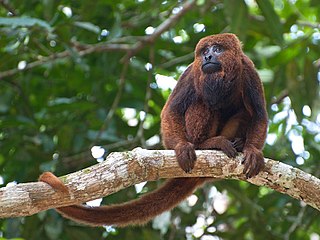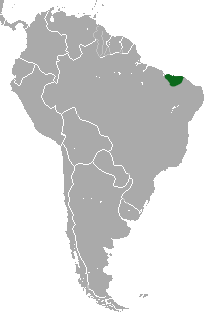
The Atelidae are one of the five families of New World monkeys now recognised. It was formerly included in the family Cebidae. Atelids are generally larger monkeys; the family includes the howler, spider, woolly, and woolly spider monkeys. They are found throughout the forested regions of Central and South America, from Mexico to northern Argentina.

The Colombian red howler or Venezuelan red howler is a South American species of howler monkey, a type of New World monkey, found in the western Amazon Basin in Venezuela, Colombia, Ecuador, Peru and Brazil. The population in the Santa Cruz Department in Bolivia was split off as a separate species, the Bolivian red howler, in 1986, and more recently, splitting off the population in northeastern South America and Trinidad as the Guyanan red howler has occurred. All howler monkeys belong to the family Atelidae and the infraorder Platyrrhini.

The brown howler, also known as brown howler monkey, is a species of howler monkey, a type of New World monkey that lives in forests in south-eastern Brazil and far north-eastern Argentina (Misiones). It lives in groups of two to 11 individuals. Despite the name "brown howler", it is notably variable in colour, with some individuals appearing largely reddish-orange or black.

The black howler or black-and-gold howler, is among the largest New World monkeys and a member of the Alouatta genus. The black howler is distributed in areas of South America such as Paraguay, southern Brazil, eastern Bolivia, northern Argentina, and Uruguay. This species is sexually dimorphic, with adult males having entirely black fur and adult females and babies of both sexes having an overall golden colouring; which emphasizes black-and-gold in the name. The IUCN Red List has classed the black howler as Near Threatened as a result of a recent population reduction due to a variety of human-caused factors.

The red-handed howler is a vulnerable species of howler monkey, a type of New World monkey. It is endemic to Brazil, found in the southeastern Amazon and disjunctly in the Atlantic Forest between Rio Grande do Norte and Sergipe.

The Bolivian red howler is a species of howler monkey, a type of New World monkey, endemic to Bolivia. It can be found in rain forests, including riverine and seasonally flooded forests.

The Amazon black howler is a species of howler monkey, a type of New World monkey, endemic to the south-central Amazon in Brazil. Until 2001, most authorities included it as a subspecies of the red-handed howler, though its distinction had already been pointed out much earlier. As suggested by its name, it typically appears entirely black.

The mantled howler is a species of howler monkey, a type of New World monkey, from Central and South America. It is one of the monkey species most often seen and heard in the wild in Central America. It takes its "mantled" name from the long guard hairs on its sides.

The Yucatán black howler, or Guatemalan black howler, is a species of howler monkey, a type of New World monkey, from Central America. It is found in Belize, Guatemala and Mexico, in and near the Yucatán Peninsula. It lives in evergreen, semideciduous and lowland rain forests. It is also known as the baboon in Belize, although it is not closely related to the baboons in Africa.
The Coiba Island howler is a type of howler monkey, a type of New World monkey, endemic to Panama. Although the Coiba Island howler has been recognized as a separate species by a number of authorities since a 1987 study of its fingerprints, mitochondrial DNA testing found it does not differ from mantled howler populations in any significant way. A reason given for treating it as a separate species is that the dermal ridges of its hands and feet differ from those of the mantled howler.

The Mexican howler is a subspecies of the mantled howler, A. palliata. This subspecies is found predominantly in forests between south eastern Mexico and north eastern Peru. Typical of its species, the Mexican howler monkey has a prehensile tail, a deep jaw, and a large pharynx which it uses to make characteristically deep and resonating howls. Mantled howler monkeys are known for forming unusually large cohorts averaging 14 members and sometimes extending to 40 members.
The red howlers are five species of howler monkeys that used to be considered conspecific:

The ursine howler is a species of howler monkey native to Venezuela and possibly Colombia. It is sometimes considered a subspecies of the Venezuelan red howler and classified as Alouatta seniculus arctoidea.

Spix's red-handed howler is a species of Howler monkey native to the southeastern Amazon in Brazil. It is threatened by deforestation and hunting.

The northern brown howler is the type subspecies of the brown howler, native to Brazil. It is listed as critically endangered, with fewer than 250 individuals restricted to the vicinity of the Jequitinhonha River. The species feeds on fruits, flowers, and by preference immature leaves which are easier to digest than mature leaves; foraging for these foods in hillside habitats was shown to require more energy expenditure than in valley habitats.

The Juruá red howler is a species of howler monkey, native to Peru and Brazil.

The Purús red howler is a species of howler monkey native to Brazil, Peru and north of Bolivia.

The Maranhão red-handed howler is an endangered species of howler monkey endemic to forests in the northeastern Brazilian states of Ceará, Maranhão and Piauí. It was previously thought to be a subspecies of the red-handed howler, but unlike that species, the Maranhão red-handed howler is strongly sexually dichromatic.


















